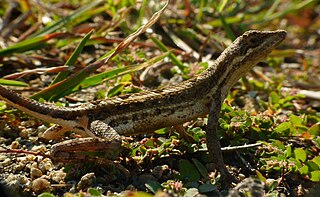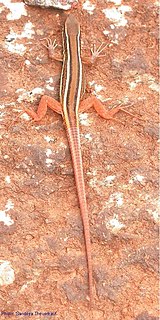
Gehyra mutilata, also known as the common four-clawed gecko, stump-toed gecko, tender-skinned house gecko, sugar gecko, Pacific gecko, or butiki, is a type of house gecko that is native to Southeast Asia. It has made its way to several areas of the world including Sri Lanka, Indochina, and many of the Pacific Islands. Compared to common house geckos, this gecko's appearance is somewhat plump, with delicate skin. The skin is usually colored a soft purplish/pinkish gray with golden spots on younger specimens; these spots eventually fade with age.

Draco blanfordii, commonly known as Blanford's flying dragon, Blanford’s flying lizard, or Blanford's gliding lizard, is a species of "flying" lizard in the family Agamidae. The species is endemic to Asia, and is capable of gliding from tree to tree.

The Caucasian agama is a species of agamid lizard found in the Caucasus, E/S Georgia, Armenia, Azerbaijan, Turkmenistan, Tajikistan, Dagestan (Russia), E Turkey, Iraq, N Iran, Afghanistan, NW Pakistan, and parts of Kashmir.

The Himalayan agama is an agamid lizard found in Central Asia and South Asia.

Laudakia tuberculata is a species of agamid lizard found in northern Pakistan, northern India, Nepal, eastern Afghanistan, and western China.

The Pondichéry fan-throated lizard is a species of agamid lizard found in eastern peninsular India. It was earlier thought to be widespread but studies in 2016 resulted in the splitting of the group into several species placed in two genera. The genus Sitana has an enlarged projecting scale on the posterior side of the hind thigh which is absent in the sister genus Sarada.

Psammophis condanarus, the sand snake, is a species of snake found in dry low country zones of Indian peninsula, Pakistan and Nepal. It is a fast-moving, diurnal, terrestrial species and lives in stony outcrops and boulders. It was first described from Ganjam area of Odisha State and then later on recorded from many parts of the Indian subcontinent.
The graceful lead-toed gecko is a species of small-sized gecko found in India. The holotype was described in British India in Berar.

The Southern Ghats slender gecko is a species of gecko with a restricted distribution in the hills of southern India.

The Indian fringe-fingered lizard, also known commonly as the Indian fringe-toed lizard, is a species of lizard in the family Lacertidae. The species is endemic to Asia.

Ophisops leschenaultii, commonly called Leschenault's snake-eye, Leschenault’s lacerta, or Leschenault's cabrita, is a species of lacertid lizard endemic to India and eastern Sri Lanka. In Sri Lanka, this lizard is called Pandura katussa in Sinhala. In some parts of the country, it is also called Heeraluwa or sikanala, which is more common name for all skink-like reptiles.
The white-spotted supple skink is a species of diurnal, terrestrial, insectivorous skink found in parts of tropical Asia. This species was first described by John Edward Gray based on type specimen collected by T. C. Jerdon from Madras, in the Coromandel Coast of South India.

The bronze grass skink, bronze mabuya or speckled forest skink, is a species of skink found in South and Southeast Asia. It is a common, but shy, ground-dwelling species that is active both day and night.

Eutropis multifasciata, commonly known as the East Indian brown mabuya, many-lined sun skink, many-striped skink, common sun skink or (ambiguously) as golden skink, is a species of skink.

Eutropis rugifera, variously known as Nicobar Island skink or rough-scaled sun skink, is a species of skink from southeastern Asia.
Ophiomorus tridactylus, commonly known as the three-toed snake skink, is a species of skink endemic to sandy desert areas of South Asia. It is also called the Indian sand-swimmer for its habit of moving just under the sand.

Sphenomorphus indicus is a species of skink.

The Noronha skink is a species of skink from the island of Fernando de Noronha off northeastern Brazil. It is covered with dark and light spots on the upperparts and is usually about 7 to 10 cm in length. The tail is long and muscular, but breaks off easily. Very common throughout Fernando de Noronha, it is an opportunistic feeder, eating both insects and plant material, including nectar from the Erythrina velutina tree, as well as other material ranging from cookie crumbs to eggs of its own species. Introduced predators such as feral cats prey on it and several parasitic worms infect it.
Trachylepis tschudii is an enigmatic skink, purportedly from Peru. First described in 1845 on the basis of a single specimen, it may be the same as the Noronha skink (T. atlantica) from Fernando de Noronha, off northeastern Brazil. T. tschudii represents one of two doubtful records of the otherwise African genus Trachylepis on mainland South America; the other is T. maculata from Guyana.
Nessia sarasinorum, commonly known as Sarasins's snake skink or Müller's nessia, is a species of lizard in the family Scincidae. The species is endemic to the island of Sri Lanka.

















